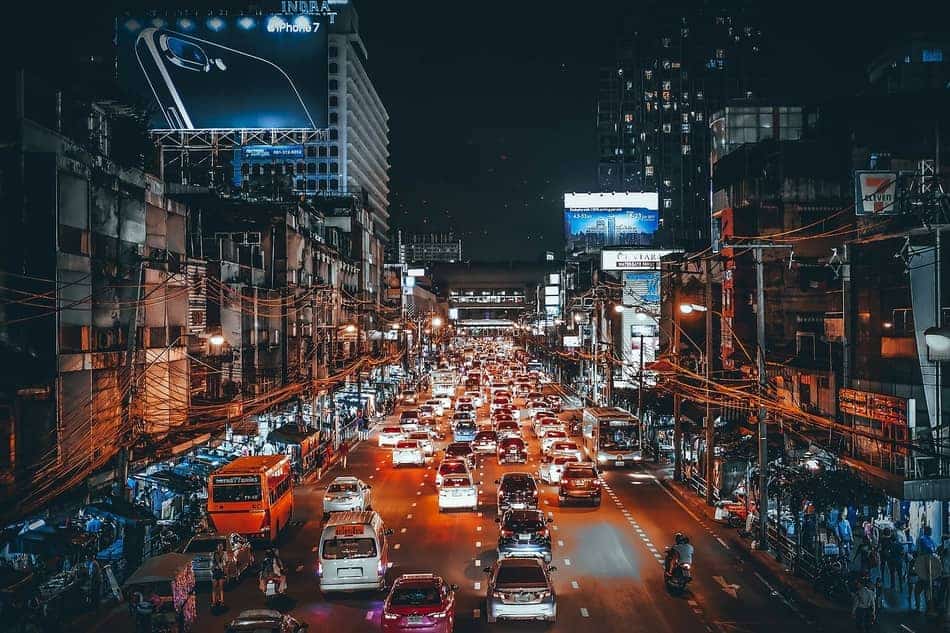
Cresting a small rise to see miles of unmoving traffic is a heart dropping yet regular occurrence for inhabitants of Bangkok. Slowly drudging through the city in long lines of traffic has become commonplace, but how did this come to be?
Bangkok’s narrow roadways developed organically over hundreds of years and weren’t able to expand as buildings were constructed too close by. Compounded with a high percentage of vehicle ownership, government officials state that there are 8x too many vehicles for the infrastructure to accommodate.
Bangkok ranks as one of the worst countries in the world in terms of traffic congestion according to tomtom. You’ll definitely experience the crawl if you visit during rush hour. I’ll go into more detail on what to expect, how the current situation came to be, and some potential solutions.
Why Is Bangkok Traffic So Bad?
How We Got Here
Bangkok is a city that traces it’s origins back to the 15th century when it was originally a trading post in the Ayutthaya Kingdom. It evolved over hundreds of years as two distinct cities, Thornburi and Bangkok. In 1971, these two cities were merged into a larger Bangkok which is the largest hub of trading and business activity in Thailand.
Bangkok is home to almost 15% of the entire population of Thailand and has an estimated 10 million residents as of 2020. With the size of Bangkok being 606 square miles, that means there are about 16,500 people per square mile. While it might not be as dense as somewhere like New York City (27,000 people per square mile), 606 square miles is a massive area to cover for public transportation and city planning. To put it in perspective, New York City is only 303 square miles.
Small Organic Roads
With the city covering such a large area and being so old, organic roads developed but weren’t large enough. Roads were unable to expand as residential development projects were placed too close to nearby roads. The pathways that developed have transformed today into what you might consider alleyways or sois. These alleyways/sois are too small to reasonably accommodate heavy traffic.
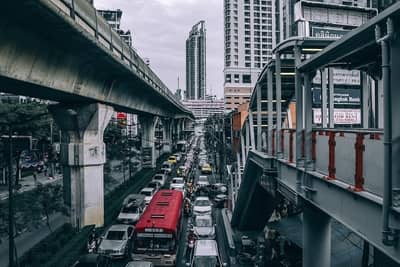
While traveling with my brother-in-law, a native of Bangkok, he regularly tried to circumvent traffic through these tiny roads and it was pretty unsettling. If there was another car coming through, getting past was extremely tight.
The main roads that run through Bangkok are not large enough to accommodate the amount of traffic. They were also squeezed in by commercial real estate projects and didn’t leave much room for road expansion.
High Number of Vehicles Per Capita
The amount of vehicles per capita is extremely high. If you look at the chart below with data obtained from the Economic Research Institute for ASEAN and East Asia, Bangkok is listed with the highest passenger vehicles per 1,000 people:
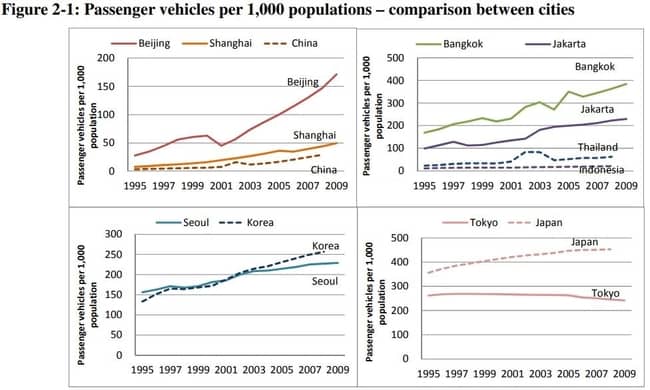
Currently there are 9.7 million registered vehicles in Bangkok. With 10 million residents that means almost every single person owns a car or has cars for their children etc. The Thai government says it has 8x more vehicles than can be properly accommodated with current roadways.
Clustered Development Blocks
Cars are seen as a status symbol and are mass produced, but another contributing factor to their over-abundance is the poor city planning. Development blocks run deep past the main roads and public transportation doesn’t have access to certain residential areas. City dwellers would be forced to walk over a mile every day to have access.
It’s much more convenient to own a motorbike or a car and navigate through sois and thus avoiding public transportation all together.
Over-Abundance of Parking
Use of private vehicles is further encouraged through the over-abundance of parking. In most countries, buildings are allotted a maximum number of parking spaces. Under the Building Control Act, commercial buildings in Bangkok are required to have a minimum number of parking spaces based on size.
More Traffic Causes More Accidents
With too many drivers on the limited roadways, the problem is exacerbated as even more accidents occur causing more traffic.
How Can We Solve Traffic Jams in Bangkok?
Add More Elevated Roadways
One solution that the city of Bangkok is working on is building elevated roadways and expressways on top of existing infrastructure. This is a good move in the right direction, but it’s not going to make enough of an impact fast enough. As the population rapidly grows and more people join the traffic in their personal vehicles, more roadways won’t develop fast enough. The real solution is to develop better public transportation.
Increase Subway and Skytrain Lines
There are some good options for public transportation, such as the BTS Skytrain (check out my article on the BTS here) or the MRT Subway, but they only cover a limited area in the inner-city. I’ve highlighted the BTS Skytrain and MRT Subway routes below from google maps to give you a better picture:
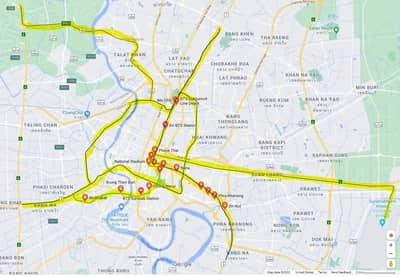
And a with wider view of the greater Bangkok area…
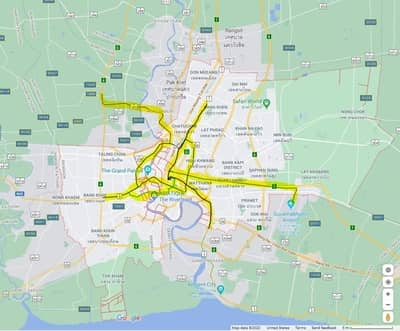
As you can see, there aren’t too many subway/skytrain lines. They city has continued construction on new lines in the past few years, but they need so much more. Only the inner-city is covered and not entirely. The only other alternatives are buses, taxis, tuk tuks, and river taxis.
Improve Buses/Routes
Buses could be a good option as they have wider coverage throughout the metropolitan area, but there are very few dedicated bus lanes. It makes it difficult to convince the mass population to use buses when they are old, lack air condition, use outdated routes, and are generally chaotic. Many buses pass by the same stops which adds to the confusion when waiting for yours to arrive, and you will be waiting quite a while. Even when yours arrives, there’s a good chance it will be full.
Probably the most important first step is to get rid of the negative stigma surrounding buses by improving routes, investing in newer buses, and creating more dedicated bus lanes.
Add Traffic Lanes
To create more lanes, wider roads must be established. There’s a few ugly ways to do this, but the first step is dealing with the over-abundance of parking. With less parking available, it will open up land for roads and encourage residents to find alternative modes of transportation. However, I’m not advocating removal of parking unless it’s used to increase the amount of roadways. If parking is removed without any trade-offs, that is simply creating a bigger problem.
Increase Walkways and Bike Paths
Another popular idea is to develop stretches of unused land beneath expressways into bike paths. Sidewalks throughout the city are extremely crowded and opening up areas for pedestrians will be important for the sustained growth of Bangkok. Any stretches of land available for use can help ease the burden on over-crowding and give the option for bikers to traverse through the city without using dangerous streets.
What Time Is Rush Hour in Bangkok?
Peak times for morning and evening rush hours are 7AM and 6PM with traffic starting as early as 5AM. Traffic usually tapers off around 10PM.
I’ve experienced the traffic first-hand and do not recommend traveling by city roads at any time of day unless necessary.
Sources:
Bangkok Vehicles per Capita: Study on energy efficiency improvement in the transport sector through transport
improvement and smart community development in the urban area Working Group
(2013), ‘An Overview of Urban Transport Situation in Asia’, in Kutani, I. (ed.), Study on
energy efficiency improvement in the transport sector through transport improvement and
smart community development in the urban area. ERIA Research Project Report 2012-29,
pp.5-14. Available at: http:/www.eria.org/RPR_FY2012_No.29_Chapter_2.pdf
